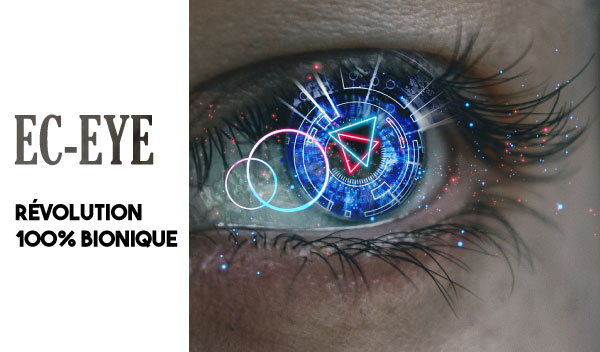REPORT Ec-Eye, the 100% bionic revolution

Faced with the problems of blindness and visual degeneration , which affect more than 200 million people worldwide according to the latest WHO report , scientific research continues to arouse hope. Many technological advances already allow visually impaired people to significantly improve their vision. Today, these devices offer them the possibility of discovering shapes or colors. But a device being developed by a team from the Hong Kong University of Science and Technology (HKUST) could change that. It's EC-Eye, a 100% bionic eye, and we'll tell you about it in this new file.
Ec-Eye, inspired by humans
Most optical devices intended to improve the vision of the visually impaired consist of grafting an implant into the eye or the brain. The EC-Eye mechanism aims to reconstruct the eye in its entirety. The University of Hong Kong therefore aims, in its research, to propose a 100% bionic eye . Not only would this restore sight to blind people, but it would be far beyond the capabilities of even the human eye.

The Electro-Chemical Eye is a so-called "biomimetic" device. This means that it is totally inspired by the human eye, from its form to its physiology. In terms of technological innovations, nano-sensors imitate the photo-receptor cells of the eye in the retina. The vitreous body is replaced by an ionic liquid. Liquid metal, rubber-coated nanocables act as optic nerves, responsible for transmitting signals to a computer system. Did you say science fiction?
The EC-Eye therefore meets all the needs of a human eye to function and can therefore replace those that are faulty. But it does not stop there. The visual abilities of this bionic eye, whose research results were published in the journal Nature as early as 2020, could simply be exceptional.
Beyond sight
Among these extraordinary capacities, how not to mention the number of photoreceptors that EC-Eye can integrate? While a human eye has 10 million of these photoreceptors, the latter can integrate 460 million. Thus, it would offer a simply exceptional resolution !

The bionic eye would also have the ability to react more quickly to changes in light. Thanks to its lens and its artificial iris, it would only take between 30 and 40 milliseconds to adapt to these light variations, compared to 40 to 150 milliseconds for the human eye.
[= ]Nanowires of perovskite, an abundant mineral, take the place of cones and rods. They make it possible to distinguish colors, but with much greater acuity than previously known.
Many more years of research needed
Currently, the EC-Eye bionic device is still far from integrating the characteristics expected of it. So why such a frenzy in the world of robotics and science ?
It remains of course important to put the data and performance of this eye into perspective. Many issues and challenges still await researchers. The prototype produced is still well below the performance of our biological eye. What allows us to believe in improvement is precisely the first results, which are often the most difficult to obtain. These are more than promising.
[ =]
While it can already detect simple shapes, both the field of vision and the resolution will improve considerably. To one day achieve the performance described above?
For Professor Zhiyong Fan, research director, it is planned " to improve the performance, stability and biocompatibility of the EC-Eye in the future. We want to collaborate with researchers in medical sciences for the use of our device as an ocular prosthesis. "
Five years to become functional
Researchers are giving themselves about five years to succeed in surpassing the visual performance of the human eye. For this, they rely on collaborations with universities in California in particular. But the scientist remains realistic: “ As regards image resolution, viewing angles and ease of use, bionic eyes today are well below the human eye. New technologies are needed to solve these problems and this is what gave me the motivation to embark on this unconventional project "
The prototype would already have the capacity to better adapt to low light and could, in the long term, allow easier night vision. Eye represents one of the greatest innovations in visual health. It is also a source of hope for a large number of visually impaired people.
There will be no shortage of funding to accelerate research. Faced with increasing health issues, science is once again proving its ability to achieve feats.


